
Location: Black Rock, VIC
Established: 1932
Architect: Alex Russell
First Played: 3rd Mar 2015
Last Played: 26th Oct 2019
Magazine Ratings

8 (Current)

7 (Current)
With so much tournament golf on TV the last few months featuring this magnificent club, I knew it was time to return. It was also a case that I had to utilise the last month of my golf membership from my former NSW club, allowing me to visit Royal Melbourne Golf Club to play the East Course as an interstate visitor. This is one thing I love about Australia is the fact we can access such superb golf courses and not always have to know a member. Playing here would also see one of my original goals completed, even before the top 100 quest, playing all the officially acknowledged Melbourne Sandbelt courses.

Royal Melbourne Golf Club was established in 1891 and is the oldest golf club in Australia without interruption. The original course was established in Caulfield until 1901, when it moved to Sandringham where it remained until 1930. After this point the club moved to its current location in Black Rock. In 1926 leading golf architect Dr Alistair Mackenzie was chosen to design the new layout, now known as the West Course. Three years later it was decided to build a second eighteen which became known as the East Course. This was designed by Alex Russell who had assisted Mackenzie with the West Course.

Office and Reception at Royal Melbourne Golf Club
Now I must admit things didn’t go quite so smoothly in getting on to the course. As there had been a tournament two weeks earlier it was a struggle to find an appropriate time. Secondly, as I’m sure most people do, I had not fully read the email sent to me with the booking details. I had overlooked the fact I had to confirm the date and time. Luckily the office staff were extremely helpful with my situation and managed to find a time slot which was not too far after my original time. It did give me a chance to look around the property a little more, so it was actually a good thing.
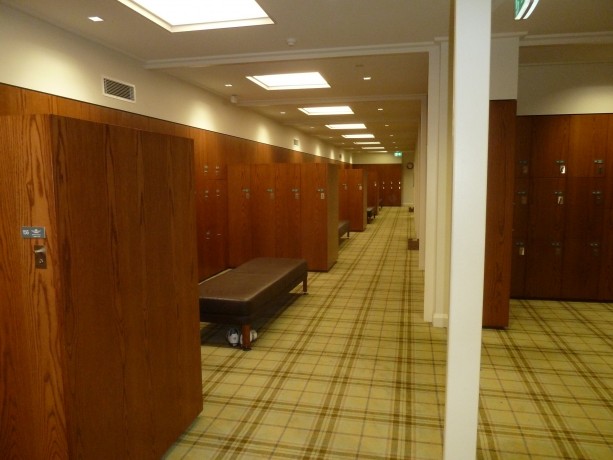
Mens locker room at Royal Melbourne Golf Club
I thought I would take the opportunity to prepare so had a sneak peek in the mens locker room. They were very modern with good facilities available to those playing.

Map of Royal Melbourne Golf Club East Course
Royal Melbourne is a 36 hole course located in the Sandbelt region of Melbourne. Being made up of the West and East course, it is actually more renown for its Composite course which is used during championships. The club has four parcels of land each divided by a road (these are not the official names):
Main block: 21 holes (West 14, East 7)
West block: 4 holes
East block 1: 3 holes
East block 2: 8 holes
Of recent years there has been variations of the Composite course used, like the Presidents Cup, which shows how much flexibility there is available. One aspect is that any significant tournaments are only held on the main block of land, I guess to reduce safety issues and people sneaking in.

Scorecard for Royal Melbourne Golf Club East Course

The 1st tee – 304 meter par 4
I had been re-scheduled to play with a threesome from China, but they preferred to play themselves, which I didn’t object too, so off I went on my lonesome. The first hole is a short par 4, but doesn’t mean it is an easy par. From the tee there is a small carry over scrub to reach the fairway. A bunker is located to the right which is in play for this hole and the West 8th hole. The fairway slopes to the left, the further left you hit, the more of the slope you will catch. My play was to hit just left of the bunker and catch the downslope.
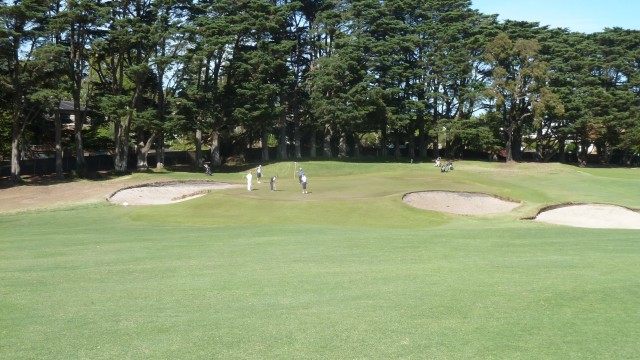
Approach to the 1st green
Your approach could vary dramatically, dependent on where the tee shot ends up. I happened to be playing from the down slope towards the green. There is a large false front then three bunkers on either side of the green. This also slopes from back to front. The one thing I did know was that it would be firm around the playing surfaces, allowing for the ball to run along the ground. Not as useful for this hole but certainly throughout the course, something to be aware of.

Hole 2 – 402 meter par 4
From the tee you can see most of this hole, the hardest on the course. Playing down hill over the first green (make sure they clear the area) the hole turns slightly to the right. Ample room out to the left, which will make the hole that much longer, which you don’t really need to do. Don’t take on too much of the right or tree trouble will become a problem. The firmness also allows the ball to run a little longer.

A long way up the hill to the second green
Hitting somewhere safe is critical on this hole. It is way too long to reach the green if you have some obstacle in the road. The hole now plays uphill to the green. Fairway bunkers are found on the right fifty meters short of the green. One large trap is left of the green with another is located on the right and rear. Anything long left will run away down a hill. Even though the greens had been sanded, it was extremely light, almost like dust and did not slow the greens down too much. I had been called through on this hole by the caddie of the foursome in front who didn’t want to hold me up, always a danger of wiping a hole as you tend to rush, which I successfully did.

Hole 3 – 350 meter par 4 – View from the fairway
The third is another great hole on the ‘original paddock’. This hole doglegs to the right and is quite easy to drive through the fairway. If shaped correctly there will be a little bit of run down the slope towards the green. You will be guaranteed a downhill slope playing to the putting surface, unless you are in the trees. Don’t try to cut too much down the right side of the fairway or you might be blocked out with your second shot.

View back of the third hole
The green is protected on both sides by two large bunkers, whilst anything slightly long will run away down a swale. This green has a couple of small undulations which can cause tricky putts, depending upon pin positions. I noticed the day I played the pin was almost at the edge to a small valley, which would gladly feed any ball away if struck slightly too hard. This is always a hole I enjoy watching during tournament time and makes or breaks some of the professionals rounds.
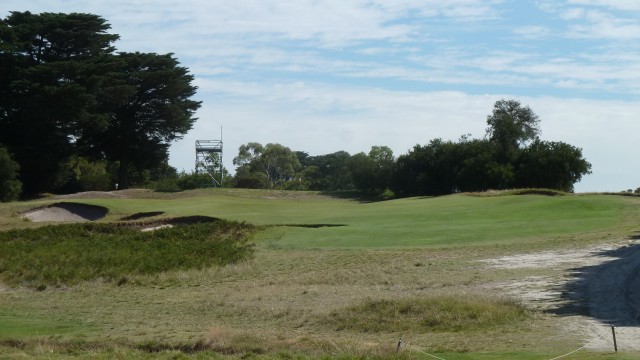
Hole 4 – 184 meter par 3
The fourth, longest par 3 on the course, plays even longer as it is all uphill. Bunkers cover the front left and right of the green. Best play is to the right if you are worried about carrying the ball to the green, as the sloping will bring the ball around. The left bunkers are quite deep so avoid at all costs.
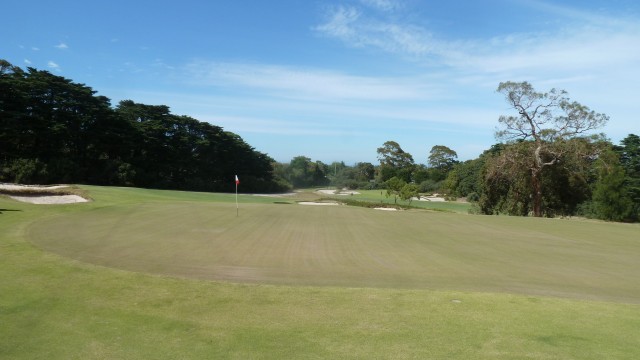
The long fourth green
The fourth green is fairly large, which it should be considering the distance, which slopes from the left to right and back to front. As long as you avoid the bunkers, as is the case on most of the holes, par should be achievable.
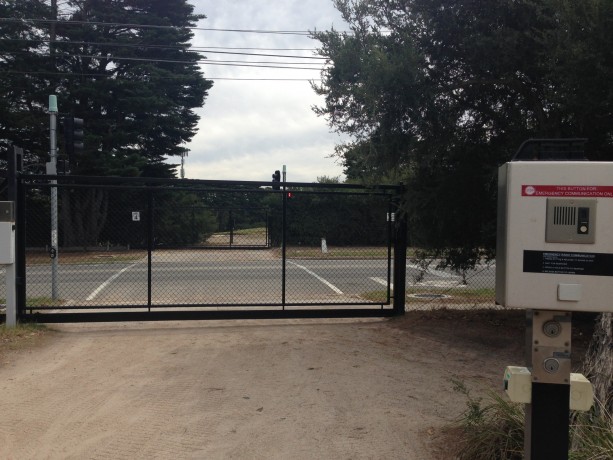
Leaving the main grounds to the second block of the East Course
The fourth is the last of the holes on the main block until you reach the 16th. This next block we cross into has three holes which are of similar design to those on the main block. We have to cross roads a total of four times when playing the East Course. Beware of the cars when crossing the road.

Hole 5 – 317 meter par 4
From this point we start to notice the surrounds of the course a lot more. The fifth hole is relatively straight, with a large mound to the right which if carried should allow the ball to run a little further down the slope. This also allows a slightly easier line into the hole. There is plenty of fairway to hit on this hole so you should be safe with the big dog.

The 5th green
The fairway narrows slightly towards the green, which then brings the bunkers on either side of the green into play. Always take note of the grass colour, as the green surrounds are usually of a different grass to the fairways. They are usually a bit firmer with the possibility of putting from off the green.

Hole 6 – 160 meter par 3
A medium length par 3 which is heavily protected by bunkers on the left, running around 50 meters out from the green. A sand trap is also located right of the green. The green looks quite a small target from the tee, however not as small as some I have come across on my travels.

The small sixth green
The green is raised, almost like a dome, leaving any balls near the edge to almost run off. It also has almost a ridge running through the middle, sloping away towards the front and the same to the rear. During my visit, aeration around the green was taking place. From here we cross another road to play holes 7 through 14.

Hole 7 – 475 meter par 5
Most of the holes on this section of the course appear quite different to those of the last two blocks of land. They almost remind me of a Parkland style course. I admit this was the least favourite part of the course for me, although I did enjoy four of the holes here.
The seventh is a long par 5 with a generous fairway to hit. Fairway traps are located down the right side of this hole, which is the route to take in making it slightly shorter.

Fairway bunkers slightly stick out enticing the ball to enter the trap
Avoid the large fairway bunker on the right to enable an attempt to reach the green in two. The fairway grass appears much greener on this section of the course. Further bunkers appear closer to the hole making the left of the fairway the safe option. Another noticable thing was the fairway being very flat, compared to other holes on the course.

The small seventh green
Another noticeable aspect on this hole was the green was fairly level with the fairway. Most others are elevated to some degree. This allows for a fairly easy chip or putt if you are short of the green.
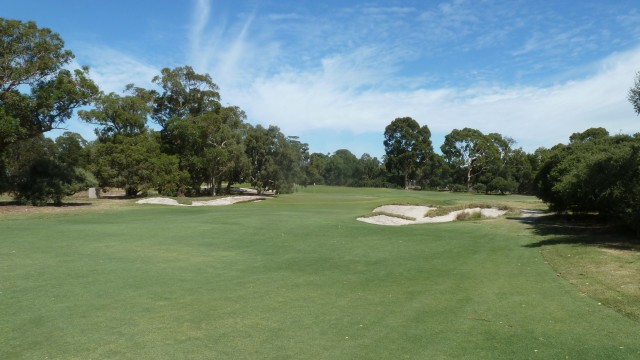
Hole 8 – 396 meter par 4 (view from the fairway)
The eighth runs between the seventh and ninth holes. This long par 4 has a dog leg to the left. A fairway bunker shared with the 7th comes into play on the left side, however playing close to this line helps to shorten the route. Again this fairway is fairly flat from tee to green.

8th green
From the fairway shot to the green, many bunkers appear down the right side, with heavy scrub also present for any wayward shot, although there is room for any miss down next to the green. The left hand side of the green has a bunker in play. This green is relatively flat with gentle slopes running off on the right and rear.

Hole 9 – 350 meter par 4
The ninth hole is a medium length par 4, which doglegs to the right. The tee shot is almost like playing through a chute. It is tempting to take some distance off by playing over the trees on the right side, but it will take one mighty big shot. Easier to play to the middle of the fairway leaving an easy approach.

Well protected 9th green
This green plays a little more interesting than the previous two, with humps, hollows, slopes and undulations found from around 30 meters out from the green, making you think about how to get the ball to the hole. Green side bunkers are left and right, cut into the green, as most are on the course.
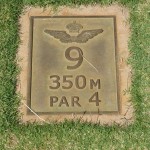

Traditional tee marker and pin flag for the East course (the West course use blue flags)

Hole 10 – 457 meter par 5
The easiest hole on the course, this mid size length par 5 takes a little strategy from the tee. The hole doglegs to the right with the best line being over the left fairway bunker. Too far left will see the ball run through the fairway. The second shot says a break in the fairway occur, only to be taken up by a multitude of bunkers leading up to the hole.

Looking back from the 10th green
Play to the left of the bunkers is possible as it is quite open, leaving a pitch shot unhindered to the green. The putting surface is fairly large and slopes mostly from the back to the front.

Hole 11 – 329 meter par 4
From the tee you cannot see the green, which can be found after taking a right hand turn halfway along the fairway. Basically this hole has the tee and green both sitting on the boundary fence, with large area of trees separating the two. You play out to the fairway then come back at the hole. I regretted not looking more closely whilst playing the last hole to see what was required. It is quite easy to play through this fairway as it is not overly long to the turning point. In hindsight you can try to take some distance off by carrying some of the trees on the right.

Playing to the 11th green
The green is narrow yet long. The bunker positioning does leave some nice shots however. With the elevated putting surface, some shots just have to be run on, especially with the pin position I faced. The only way I could see the ball getting anywhere near the pin was putting around this bunker. Getting the pace right would see the ball start to loose speed once reaching the green surface, then making its way down to the pin cut close against the bunker. Well that was what should have happened, well would have if it was hit hard enough. Instead I saw the ball speed drop off then turn towards the sand. The putting surface has some gentle slopes and undulations. This hole was a pleasure to play, even though it did not appear that way when first setting out. So many different options can be taken with lots of different results.

Hole 12 – 412 meter par 4
When I first stepped onto the tee I thought this hole looked like to should be located at Augusta National, not Royal Melbourne. After playing I still stick by this view, but that does not mean I didn’t enjoy it. You are presented with a wide fairway, narrowing as you reach the turning point. Too far right does not leave a shot into the green, well not without a lot of shape anyway. Playing out to the left makes for a very long shot to the green, something that is not required when the hole is already 412 meters.

Approach from the 12th fairway
The approach to the green is going to be a long iron. Large bunkers are built into a mound to the left and only come into play with a mishit. The appearance almost looks like a saddle, but this is not the case as the green is a bit back from these traps. A green side bunker protects the right side, however the green is quite wide, allowing you to find the putting surface from a fair distance. Generally the slope is left to right on this green.

Hole 13 – 135 meter par 3
The shortest par 3 on the East course, has bunkers leading up to the hole on the center to right side. Traps were also located to the left of the green. This has an area running in from the center to run the ball in. As we can see maintenance was being carried out during play, sanding the front of the green.

The smallish 13th green
The green isn’t overly large and has some varying slopes, however none to significant. If the greens are firm there is always the possibility of playing from one bunker to another, as they are cut right into the green. The rear slopes away but has a large area for the balls to collect in.

Hole 14 – 393 meter par 4
The fourteenth hole is a long with a dogleg to the left. From the tee the fairway looks tight, with trees either side and a trap comes into play on the left. There is a large tree standing out to the right of the trap which will see you avoid trouble. You are then left with a long shot to the green which is elevated and has a bunker to the left. It was on this hole that the battery on the camera decided to stop working so the rest of the phone photos maybe slightly grainy.

Hole 15 – 277 meter par 4
Crossing the road back to the second block, I was glad to be back to land I find more familiar with the main part of the course. Here we play only one hole, which is a great risk reward hole, being a short par 4. From the tee you can see the reward, hitting the green in one (or being close), but also the risk in all the bunkers and scrub down the right. There is also a narrow landing area in front of the green, which if over hit would find trees.

The raised 15th green
Anything right of the green finds scrub, waste or sand. There is also the problem of playing over bunkers to a raised green on which the putting surface is not overly big. Great hole design is all I can say.

Hole 16 – 151 meter par 3
Probably one of the holes I was most looking forward to on this trip. Having seen this in play during the Presidents Cup in 2011, I had dreamed of playing this hole. This is not part of the standard composite course, although I would debate anyone on this why it isn’t. Not following the best design principles as you have to carry the bunkers to get to the green, this hole almost the equivalent of TPC Sawgrass 17th, except it is sand instead of water (note I said almost, I do realise it is not fully surrounded)

The tricky 16th green
The green is quite generous out to the right, however pin positions on the left are a lot tighter. The worst place to put a ball with these pin positions would be in the left trap or beyond as it will be impossible to leave the recovery shot anywhere near the pin. I have seen many a professional come undone on this hole. As for the putting surface itself has some small slopes to contend with, so leaving long putts near the hole is tricky indeed.

Hole 17 – 520 meter par 5
The longest hole on the course is the penultimate hole. From the tee you play with a slight curve to right. The fairway is quite large with plenty of room to land the ball. Don’t go to far to the left or you might be in trouble with the trees behind the West 3rd tee. Too far right brings trees also into play and out of bounds for any really wild shot. For the second a line of bunkers run diagonally away from the fairway centre, to the right. Carrying these leaves a simple pitch or wedge shot to the green.

17th green and its views back towards the clubhouse
One bunker protects the right side of the green, but the putting surface is fairly large with a small swale in the middle left. As with most of the greens it is best to allow the ball to release a little as there is virtually no chance of having the ball grip and spin back. We get a great view over the West 1st green and the clubhouse from the 17th.

Hole 18 – 395 meter par 4 (view from the fairway)
The last hole, for both the East and Composite course is a great way to finish the round. From the tee you play to a fairly open fairway, except the clump of trees separating the Wests 1st and East 18th fairway. Play far enough left and they don’t even come into play, but you just made the hole a little longer.
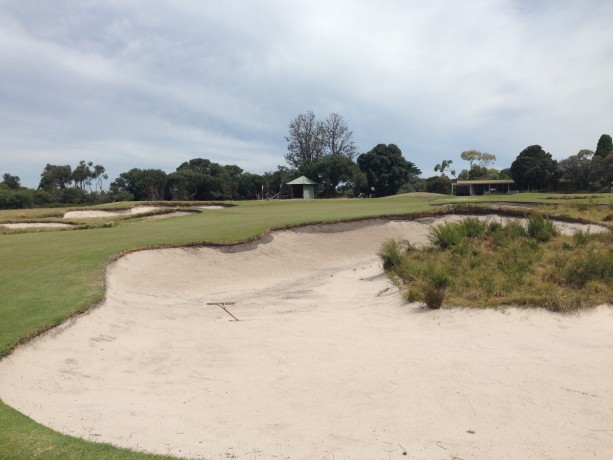
Island in the bunker on the 18th green
It’s playing to the green where this hole is won or lost. Bunkers surround three quarters of the large putting surface, but do leave an opening into the right hand side. There is also a false front leading in from this direction, so club selection is essential. Some of the bunkers surrounding this hole are large enough to have islands in the middle. The most common place for pin positions are on the left, especially during tournaments, hidden behind some of the sand traps. The green slopes from the rear to the front and can leave some long two putts if you are out of position. This hole was a joy to play and finish the round on.
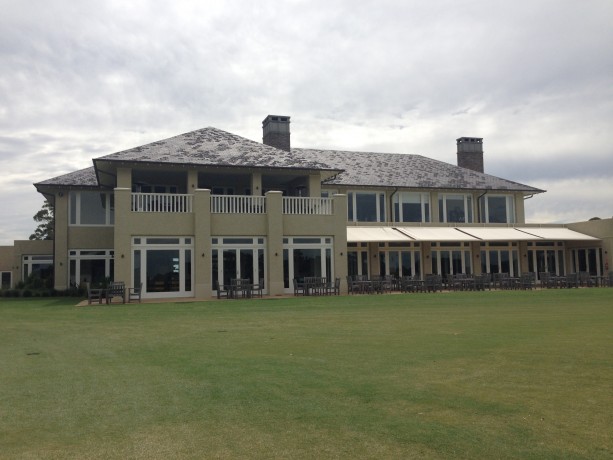
Royal Melbourne Golf Club – Clubhouse overlooking the East 18th green
Now it was time to go and sit back, enjoy a few ales and have some lunch. The food offered in the clubhouse was of a high standard with a large selection of beer and wine to choose from.


Some of the memorabilia located in the clubhouse
Take the time to have a wander around to check out some of the older golf equipment. I think this was the first time I had actually seen a Gutty ball.

Clubhouse interior – great spot to reflect on your round and watch other groups coming in
In summary I can say you will never be disappointed in playing a round at Royal Melbourne Golf Club, on either course for that matter. The conditioning of the course was almost immaculate, even with the sanding that had occurred on the greens. Strategy plays a big part in playing most of the holes located on the East course. As mentioned I did notice a big difference between holes on the outer part of the land, as opposed to those in the main block. I didn’t notice this being as big a difference when I played the West Course. But this would not prevent me playing the East course again. The staff are extremely friendly, which I find refreshing considering this is one of the most exclusive golf clubs in Melbourne. However my next goal is to play the Composite course which I can hopefully do next year when an open or charity day is held.
To play Royal Melbourne you need one of the following:
1. Be invited by a member
2. Interstate or overseas visitor (must be a member of a golf club). Contact the Royal Melbourne Golf Club
3. Play one of the open days held throughout the year

